This is a financial promotion for The First Sentier Global Listed Infrastructure Fund. This information is for professional clients only in the EEA and elsewhere where lawful. Investing involves certain risks including:
- The value of investments and any income from them may go down as well as up and are not guaranteed. Investors may get back significantly less than the original amount invested.
- Currency risk: the Fund invests in assets which are denominated in other currencies; changes in exchange rates will affect the value of the Fund and could create losses. Currency control decisions made by governments could affect the value of the Fund's investments and could cause the Fund to defer or suspend redemptions of its shares.
- Single sector risk: investing in a single economic sector may be riskier than investing in a number of different sectors. Investing in a larger number of sectors helps to spread risk.
- Listed infrastructure risk: the infrastructure sector and the value of the Fund is particularly affected by factors such as natural disasters, operational disruption and national and local environmental laws.
- Concentration risk: the Fund invests in a relatively small number of companies which may be riskier than a fund that invests in a large number of companies.
- Emerging market risk: Emerging markets tend to be more sensitive to economic and political conditions than developed markets. Other factors include greater liquidity risk, restrictions on investment or transfer of assets, failed/delayed settlement and difficulties valuing securities.
For details of the firms issuing this information and any funds referred to, please see Terms and Conditions and Important Information.
For a full description of the terms of investment and the risks please see the Prospectus and Key Investor Information Document for each Fund.
If you are in any doubt as to the suitability of our funds for your investment needs, please seek investment advice.
- Global listed infrastructure’s defensive growth characteristics see it well positioned to navigate a world of deglobalisation, debt and disorder
- Infrastructure enjoys popular voter support and a strong investment backdrop at a time when governments struggle with high levels of indebtedness
- In this situation we believe global listed infrastructure can deliver higher earnings growth and relatively lower risk, creating an attractive risk‑return opportunity for asset allocators
Introduction
The global political economy is rapidly evolving. The rules, norms and institutions that govern interactions between nation states are being upended, and the nature of capitalism is changing again. Having evolved in the past from laissez‑faire to Keynesianism to free market neoliberalism, it is now turning to nationalism with more state intervention.
These changes herald an age of deglobalisation, debt and disorder. We believe they have significant implications for the risk and return profile of financial assets over the next decade. The following paper reviews the potential implications of these changes on the global listed infrastructure asset class and the outlook from here.
Investors facing a new world order
Over the next decade, we believe investors will face a world of deglobalisation, debt and disorder. The relative stability and strong investment returns of the post‑Cold War era may well be coming to an end.
Deglobalisation began after the global financial crisis. It is now accelerating as the US and China try to decouple their economies and appear likely to continue to do so, driven by economic nationalism.
The western world is mired in unprecedented (for non‑wartime) government debt levels, with politicians globally seemingly addicted to fiscal deficits. The world’s next debt crisis appears likelier to emerge from within developed markets than from – historically the more prone – emerging markets.
The problems caused by deglobalization and high indebtedness will likely be amplified by disorder in the global political economy, stemming from nationalism, populism, intergenerational conflict, corruption, hybrid warfare and a return to great power conflict, with Russia and China each seeking to re‑establish their former empires.
Deglobalisation, debt and disorder will have an adverse effect on the risk/return equation for investors. Risks will increase, impacting equity risk premiums, interest rates and foreign exchange rates. At the same time, we believe returns will be negatively impacted by lower economic growth rates, rapidly changing operating environments, increased government intervention and higher volatility in corporate earnings.
Just as the fall of the Berlin Wall in 1989 resulted in a ‘peace dividend’ for investors, this new world order now appears likely to lead to a lower return, higher risk investment environment.
Chart 1: Government debt-to-GDP for 20 largest economies
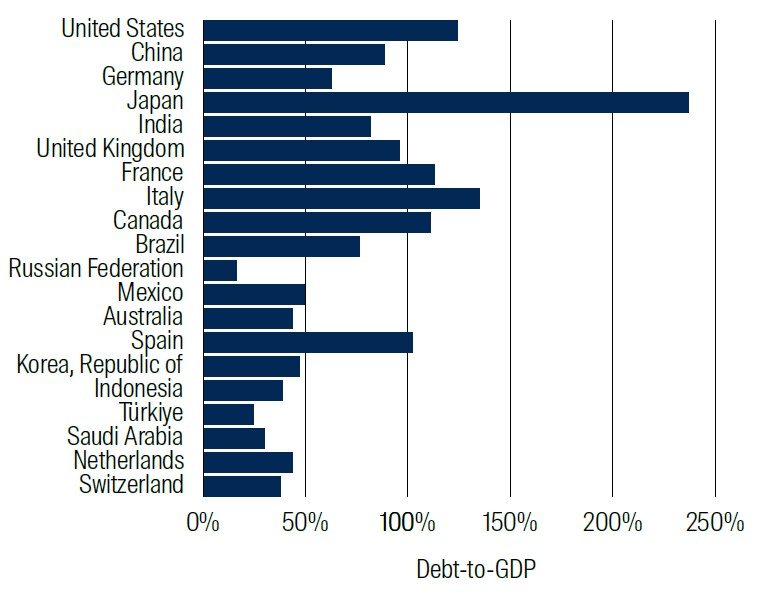
Source: World Bank, Trading Economics. Data as at 31 December 2024.
Infrastructure can shine in this darker new world
Within this new world order, society’s demand for new, improved or replacement infrastructure remains strong across both developed and developing countries. Whether you are a populist, nationalist, socialist, centre‑left or centre‑right politician, better infrastructure is on your agenda. Countries may now be turning inward from globalism to nationalism. However, investment will still be needed to replace aged infrastructure, expand urban development and provide a backbone for the structural growth of the digital economy.
Chart 2: The US government deficit is historically large
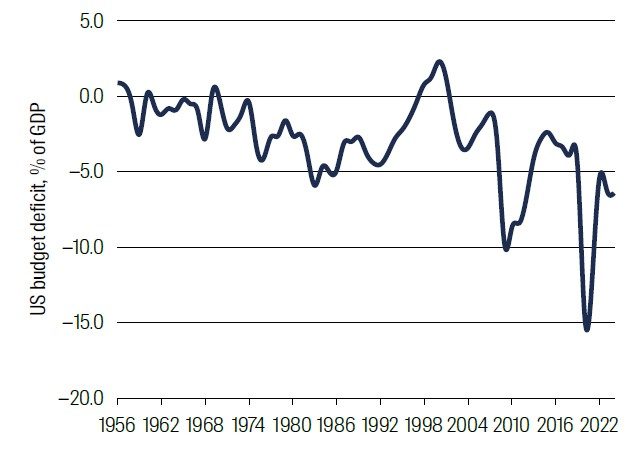
Source: First Sentier Investors, Congressional Budget Office. Data as at 31 December 2024.
What is changing is governments’ ability to fund infrastructure investment. Large fiscal deficits – leading to higher debt levels, leading to slower economic growth – mean that governments will be less able to fund infrastructure investment in the future.
Hence, we believe that private sector capital will play a larger role in infrastructure investment going forward. This means governments will need to provide attractive investment frameworks to entice increased capital to develop new infrastructure. The United Kingdom’s water utilities and electricity utilities in Texas are already seeing improvements to their respective investment frameworks.
A growing role for private sector capital in infrastructure could include the privatisation of existing government infrastructure. While not politically popular, fiscal reality is already biting in many parts of the globe. In the past two years we have seen the listings of Tokyo Metro and Athens Airport; several new Managed Lane projects in the United States; toll road privatization in Brazil and the development of new privately owned and operated airports in India.
We have also noted with interest that where governments have had the opportunity to nationalise infrastructure assets over the last few years (high profile examples include listed electric utility PG&E in United States, and unlisted water utility Thames Water in the UK), they have declined to do so. We believe this is partly due to not wanting to add to existing public finance pressures and partly not wanting government to take responsibility for these difficult, politically sensitive assets.
Chart 3: US public spending on infrastructure, % GDP
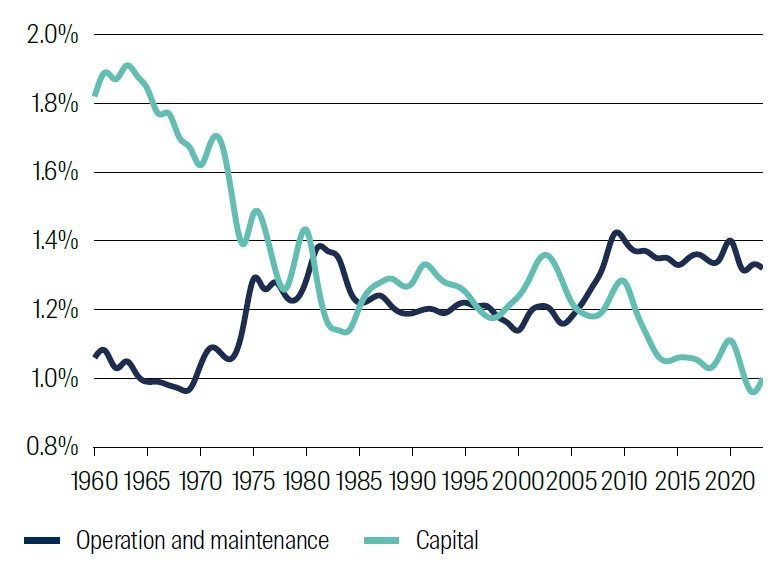
Source: First Sentier Investors, Congressional Budget Office. US Transportation and Water Infrastructure, 1960–2023. Data as at 31 December 2023
Global listed infrastructure in the new world order
The global listed infrastructure asset class is well equipped to live, thrive and survive in a world of deglobalisation, debt and disorder. These assets are foundational to modern economies and societies, making them indispensable regardless of geopolitical or macroeconomic conditions. Infrastructure assets’ strong pricing power, high barriers to entry, structural growth and predictable cash flows provide investors with defensive growth.
Deglobalisation is likely to cause disruption across the global economy; and to result in lower economic growth rates. These are both negative factors for equities’ earnings growth. In contrast, infrastructure’s essential service nature should help to shield it from the disruptive and dampening effect that deglobalisation has on economic activity levels.
High governments debt levels are also likely to weigh on economic growth and to lower long‑term interest rates. Historically, high debt burdens have tended to constrain a country’s economic growth rate. This in turn lowers earnings growth potential and valuation multiples – more so for equities than for global listed infrastructure. High debt levels are also likely to reduce the long‑term neutral interest rate level required to manage debt serviceability. This phenomenon has been observed in Japan and in parts of Europe. Lower long‑term interest rates tend to favour interest rate‑sensitive asset classes, including global listed infrastructure.
A disorderly, less predictable and more fragmented world will adversely affect all investments. This is because investors value predictability and growth; and prefer to avoid volatility.
In this situation, global listed infrastructure’s essential services provide a relatively high level of predictability. No matter how disordered the world becomes, infrastructure’s electricity, natural gas, water, cell phone, waste collection service, toll road or airport will remain in demand.
Global listed infrastructure’s business models have never been more robust
Moving from a macro to a more micro level, the underlying business models of global listed infrastructure have never been more robust during the 20 years the asset class has existed than now.
Starting with utilities, especially electric utilities; the demand, investment and earnings growth outlook for the next decade is accelerating. This is due to a number of structural factors including:
- Artificial Intelligence (AI) ‑driven data centre expansions,
- the electrification of transportation,
- the electrification of buildings,
- gas‑to‑electric switching and
- further decarbonisation of the electricity generation fleet (coal‑to‑gas‑to‑renewables‑to‑nuclear).
Not only is the growth outlook for electric utilities accelerating, but regulatory risk is also reducing. This is a reflection of the urgent nature of current demand growth, which makes regulators (and their political masters) more positively disposed towards paying a fair return on investments which bring economic development (and employment opportunities for voters).
Chart 4: US electricity demand ('000MWh)
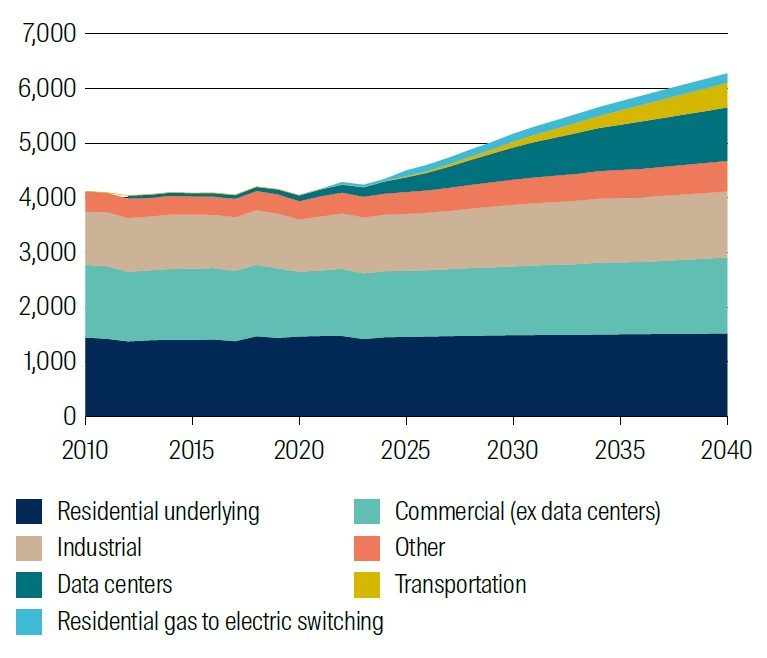
Source: First Sentier Investors forecasts. Data as at 30 June 2025.
The outlook for investment opportunities related to digital infrastructure (mobile towers, data centres and fibre) is also robust. The mobile tower industry is progressing with the installation of 5G equipment, as network operators seek to improve and increase their coverage to support consumer mobility of audio and video data. The next step change will likely come from new demand being driven by the Internet of Things and autonomous vehicles. Data centre growth is accelerating, driven by the early stages of the AI industrial revolution. Given the copious amounts written elsewhere on this topic, I will not expand on this point in this paper.
Chart 5: AI is the key driver of growth in demand for data center capacity
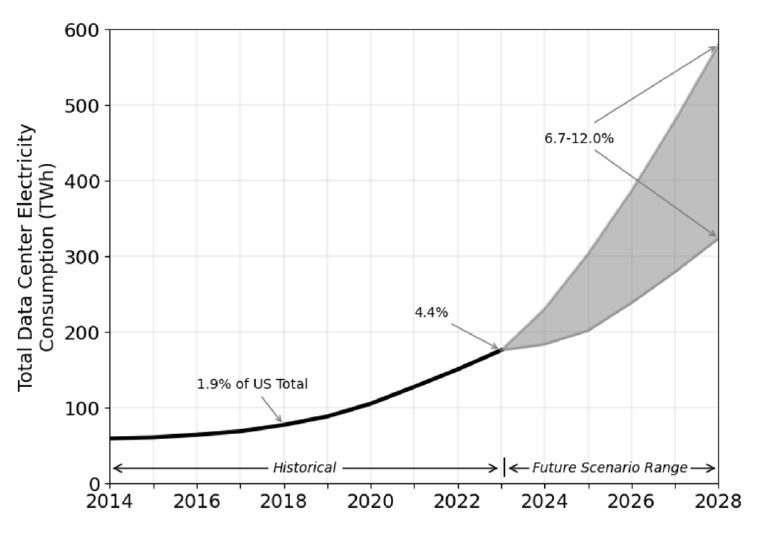
Source: U.S. Department of Energy. Data as at 20 December 2024.
The North America‑focused, historically cyclical energy midstream sector (oil and natural gas transportation and storage assets) appears well‑positioned to deploy capital to support the demand growth for natural gas. Demand is being driven both domestically, for consumption within the United States, and from overseas, as natural gas exports from the US and Canada displace (1) Russian energy in the western world and (2) coal in the developing world.
Chart 6: US natural gas usage by sector (bcf/d)
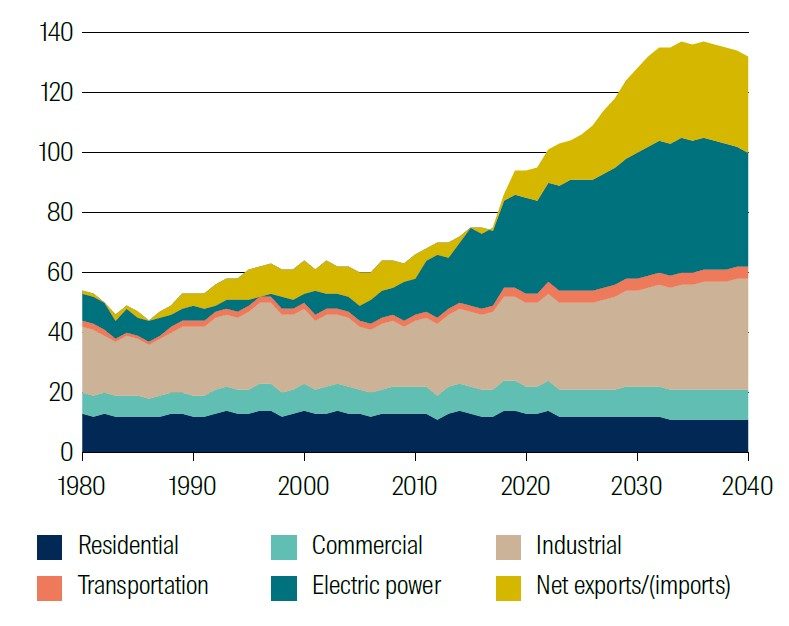
Source: Energy Information Agency and First Sentier Investors forecasts. Data as at 30 June 2025.
Transport infrastructure (toll roads, airports, railroads) appears set to benefit from several structural tailwinds to investment over the next decade. Toll roads represent the outsourcing of taxation by highly indebted governments to deliver the new road capacity that is needed for urbanisation and economic development in the developing world and for congestion reduction in the developed world. While toll roads are not popular with voters, politicians appear unable to raise taxes to replace these “user‑pays” assets, i.e. toll roads are the lesser of two evils.
Airport investment has restarted after a COVID‑driven pause, with the popularity of leisure travel defying the deglobalization trend. We believe that above‑GDP growth in leisure travel in the developed world is being driven by the generational tailwinds of baby boomers’ wealthy retirement and Gen Z fear of missing out (FOMO). In the developing world, we expect continued strong growth from the emerging middle class.
Railroads – both freight and passenger – remain in a long‑term market share fight with trucks and airlines but have structural advantages over both in terms of lower costs, lower carbon emissions, strong community acceptance and larger automation advantages.
In the almost 20 years that our team has been researching global listed infrastructure, we have never been so optimistic about the current business models and future growth prospects of the asset class. In contrast to different points over the past decade, no‑one today is contemplating the utility death spiral, stranded asset risk owing to natural gas being phased out by 2030, or toll roads being disrupted by flying cars.
Higher earnings growth and lower relative risk?
Over the next decade we believe the global listed infrastructure asset class can deliver higher earnings growth to investors, despite a lower growth world of deglobalisation, debt and disorder. Our confidence in this view is based on the bottom‑up, structural growth drivers of infrastructure’s various subsectors listed above.
We believe that through the cycle, asset class fundamentals support Earnings Per Share growth of between 5% and 6% per annum, plus a dividend yield of between 3% and 4%, giving what we believe is a highly competitive total return of between 8% and 10% per annum.
Chart 7: GLI sector total return components (2005–25)
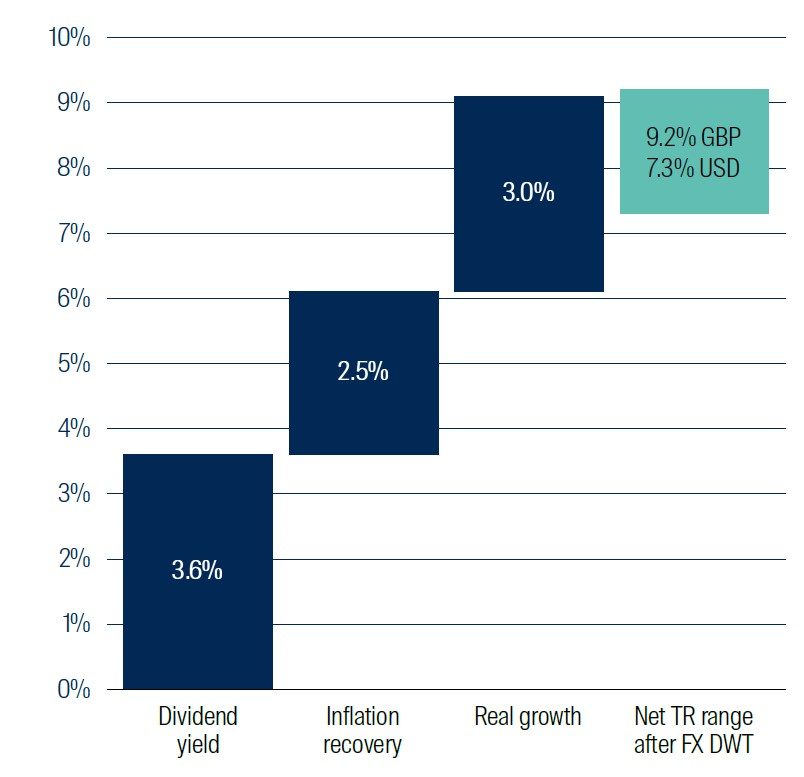
FTSE Global Core Infrastructure 50/50 Net TR Index.
Source: First Sentier Investors, FTSE. Data as at 30 June 2025.
Past performance is not an indication of future performance.
In addition to delivering robust returns, we believe that risks for global listed infrastructure can be relatively lower in a world of deglobalisation, debt and disorder. This lower risk comes from a societal demand for improved infrastructure. Nationalism means a more domestic focus, which means more infrastructure investment. Political and regulatory risk for electric utilities and energy midstream are reducing, owing to higher economic development demands being driven by data centres and by national security concerns.
In addition, rising government debt means that governments will increasingly need to rely on private sector capital. As a result, they will face increased pressure to offer a favourable investment environment, with attractive and predictable risk‑adjusted returns.
Conclusion
The global political economy is rapidly evolving. The next decade is likely to be characterised by deglobalisation, debt and disorder.
Despite a slower growth, higher risk global economic environment, we believe global listed infrastructure can deliver higher earnings growth with lower relative risks, enhancing the appeal of the asset class relative to bonds or equities.
Global listed infrastructure’s defensive growth characteristics and improving demand outlook see it well‑positioned to deliver attractive risk‑adjusted returns to investors.
Global Listed Infrastructure
Infrastructure powers the world we live in – and when it comes to on-the-ground research, our team can be found on site
Investing in global listed infrastructure can offer inflation-protected income and steady capital growth from real assets delivering essential services. We search for best-in-class assets worldwide with high barriers to entry, structural growth and pricing power.
Read our latest insights
Important Information
This material is for general information purposes only. It does not constitute investment or financial advice and does not take into account any specific investment objectives, financial situation or needs. This is not an offer to provide asset management services, is not a recommendation or an offer or solicitation to buy, hold or sell any security or to execute any agreement for portfolio management or investment advisory services and this material has not been prepared in connection with any such offer. Before making any investment decision you should consider, with the assistance of a financial advisor, your individual investment needs, objectives and financial situation.
We have taken reasonable care to ensure that this material is accurate, current, and complete and fit for its intended purpose and audience as at the date of publication. No assurance is given or liability accepted regarding the accuracy, validity or completeness of this material and we do not undertake to update it in future if circumstances change.
To the extent this material contains any expression of opinion or forward‑looking statements, such opinions and statements are based on assumptions, matters and sources believed to be true and reliable at the time of publication only. This material reflects the views of the individual writers only. Those views may change, may not prove to be valid and may not reflect the views of everyone at First Sentier Investors.
About First Sentier Investors
References to ‘we’, ‘us’ or ‘our’ are references to First Sentier Investors, a global asset management business which is ultimately owned by Mitsubishi UFJ Financial Group. Certain of our investment teams operate under the trading names AlbaCore Capital Group, FSSA Investment Managers, Stewart Investors, RQI Investors and Igneo Infrastructure Partners, all of which are part of the First Sentier Investors group.
We communicate and conduct business through different legal entities in different locations. This material is communicated in:
- Australia and New Zealand by First Sentier Investors (Australia) IM Ltd, authorised and regulated in Australia by the Australian Securities and Investments Commission (AFSL 289017; ABN 89 114 194311)
- European Economic Area by First Sentier Investors (Ireland) Limited, authorised and regulated in Ireland by the Central Bank of Ireland (CBI reg no. C182306; reg office 70 Sir John Rogerson’s Quay, Dublin 2, Ireland; reg company no. 629188)
- Hong Kong by First Sentier Investors (Hong Kong) Limited and has not been reviewed by the Securities & Futures Commission in Hong Kong. First Sentier Investors, FSSA Investment Managers, Stewart Investors, RQI Investors and Igneo Infrastructure Partners are the business names of First Sentier Investors (Hong Kong) Limited.
- Singapore by First Sentier Investors (Singapore) (reg company no. 196900420D) and this advertisement or material has not been reviewed by the
- Monetary Authority of Singapore. First Sentier Investors (registration number 53236800B), FSSA Investment Managers (registration number 53314080C), Stewart Investors (registration number 53310114W), RQI Investors (registration number 53472532E) and Igneo Infrastructure Partners (registration number 53447928J) are the business divisions of First Sentier Investors (Singapore).
- United Kingdom by First Sentier Investors (UK) Funds Limited, authorised and regulated by the Financial Conduct Authority (reg. no. 2294743; reg office Finsbury Circus House, 15 Finsbury Circus, London EC2M 7EB)
- United States by First Sentier Investors (US) LLC, authorised and regulated by the Securities Exchange Commission (RIA 801-93167)
- other jurisdictions, where this document may lawfully be issued, by First Sentier Investors International IM Limited, authorised and regulated in the UK by the Financial Conduct Authority (FCA ref no. 122512; Registered office: 23 St. Andrew Square, Edinburgh, EH2 1BB; Company no. SC079063).
To the extent permitted by law, MUFG and its subsidiaries are not liable for any loss or damage as a result of reliance on any statement or information contained in this document. Neither MUFG nor any of its subsidiaries guarantee the performance of any investment products referred to in this document or the repayment of capital. Any investments referred to are not deposits or other liabilities of MUFG or its subsidiaries, and are subject to investment risk, including loss of income and capital invested.
© First Sentier Investors Group
Get the right experience for you
Your location :  Ireland
Ireland
Australia & NZ
-
 Australia
Australia -
 New Zealand
New Zealand
Asia
-
 Hong Kong (English)
Hong Kong (English) -
 Hong Kong (Chinese)
Hong Kong (Chinese) -
 Singapore
Singapore -
 Japan
Japan
















 United Kingdom
United Kingdom 